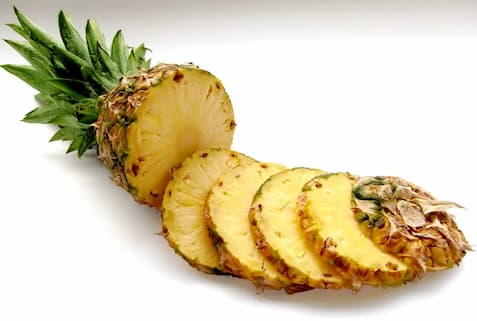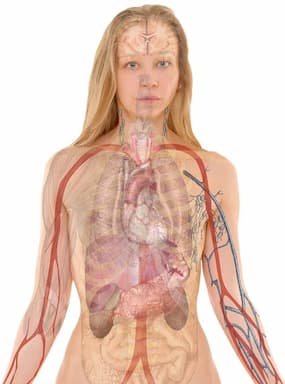This section describes how Traditional Chinese Medicine (TCM) conceives the organization of the human being and how it considers the imbalances that can affect its main components:
- the Viscera (ZangFu);
- the Substances;
- the Meridian Linking Network (JingLuo) which allows the exchange of Substances between the Viscera and all the components of the body such as the organic tissues, the trunk, the head, the limbs, etc.
At the next level, all these elements, and more particularly their relations and interactions, are described in more detail.
A holistic physiology
In Western medicine, anatomy and physiology are very descriptive and detailed. They are based on important notions of chemistry and biochemistry and accurately describe cells, glands, tissues and different systems (immune, digestive, circulatory, reproductive, etc.). In addition, they provide a thorough description of the biochemical interactions between nutrients, enzymes, neurotransmitters, hormones, etc. It explains that all these elements and systems are involved in homeostasis, i.e. maintaining the individual's various physiological constants at their normal value: temperature, cardiovascular tone, blood composition, acid-base balance, etc.
In TCM, a few texts, defining the characteristics and functions of Viscera, Substances and Meridians, serve as a physiological presentation. Although there are some rather rough descriptions of the shape and weight of certain Organs observed with the naked eye during rare dissections, the physiology of TCM includes mainly an analogical description of the role of Viscera and tissues. Traditional Chinese physiology speaks the old language of images. It privileges the correspondences between different organic components whose complementary functions it considers to be complementary, whether they are Viscera, tissues, sensory openings or even emotions and psychic activities.
A whole greater than the sum of its parts
Through observation, Chinese doctors have found that the various components of the body form affinity networks under the umbrella of one of the five major organs: Heart, Lung, Spleen/Pancreas, Liver and Kidneys. These five Organs participate collectively in the balance, both physical and psychic, of the organism, thanks to their network of influence and to the management of the substances they preserve or put in circulation throughout the organism through the intermediary of the Meridians. (See Organic Spheres.)
For example, the Liver manages the Blood, promotes the free circulation of Qi, influences the circulation of Organic Liquids, digestion, muscular activity, vision, mood (frustration, anger, moroseness), menstruation, etc. (See Organic Spheres). Moreover, its functioning, good or bad, will have a specific impact on other visceral systems and functions. It is therefore from a set of concrete, clinically observable signs that TCM will recognize the proper functioning or pathological state of an organ and its sphere of influence.
This physiology may seem simplistic. In fact, it has the shortcoming of not being very detailed and would not be of much help when performing an operation on the brain... On the other hand, it has the advantage of taking into account the whole person in a perspective where the environment, lifestyle, emotions and even personal and spiritual values are intimately linked to health and medicine. This explains in part its effectiveness in the face of chronic or degenerative diseases.
The environment as part of human physiology
When TCM defines the framework for the development of an imbalance or disease, it uses the terms External and Internal, which evoke a relationship between the organism and its environment.
Life is essentially a process of exchange, where our organism must continually assimilate, transform and then reject a multitude of nutritional inputs from the environment: Air, Food and stimuli. The environment is therefore considered an integral part of our "external" physiology. And this environment is itself constantly in transformation, and affected by occasional or cyclical changes. All these transformations imply a constant adaptation on the part of our organism so that it remains authentic (Zhen) or correct, (Zheng) to echo both philosophical and medical terms used by TCM. In order to remain ourselves in spite of this incessant renewal of what constitutes us, we call upon another component of our physiology: the Three Treasures of Life.
The Three Treasures of Life
These three treasures represent three forces of our vitality that we perceive through their manifestations, without being able to touch them with our fingers.
- The Shén. They are the Spirits who inhabit us. They allow us to be conscious, to direct our life, to follow our aspirations, to give a purpose to our existence. The Shen manifest themselves from the first hours of our existence by a will to exist, and develop according to the experiences of life. (See Spirits.)
- The Jing. Precursors of materiality, they are Essences - in the sense of essential and original -, a little like invisible plans and specifications that weave the necessary weft for the manifestation of the Shen. The Essences received from our parents contain the plans of our organism and determine how we will build ourselves: they are the innate or prenatal Essences (see Heredity). Other Essences, called acquired or postnatal, are the result of the transformation of Air and Food.
- The acquired Essences can be renewed permanently while the innate Essences wear out and are not renewable. Their decline leads to signs of aging and then death. However, it is possible to save them and take care of them, which is one of the keys to health. (See Substances.) Essences also serve as a support for memory.
- The Qi. Regarded as "the universal energy", it is the subject of a complete fact sheet. In the body, it is perceived as an amalgam of "densified" breaths. It then takes the form of Substances such as Blood or Organic Liquids, which circulate in the body through the networks of different Meridians and vessels to reach all tissues. It also represents the dynamic force that allows the body to accomplish all of its functional activities. Thus, Qi in its dynamic aspects is at the origin of the movement of various Substances which are stable and condensed forms of the same Qi. Just like the acquired Essences, the Breaths must be constantly nourished in order to renew themselves.
The pure and the impure
Pure and impure are the terms used to qualify the states of Qi. The most refined states are said to be pure; the coarse states (before processing) and the degraded states of the residues are said to be impure. In order to maintain its integrity, the organism constantly assimilates and settles the different Qi states circulating in the body. These operations aim at the maintenance and preservation of the material framework of the organism, considered as a pure substance.
The decantation of the pure and the impure is done through the Viscera. According to their relationship with the pure and the impure, they are classified into two categories, the entrails (Yang) and the organs (Yin). The Bowels are responsible for receiving the impure Qi, in the form of Food, extracting the pure components, and then rejecting the impure. For example, the Stomach receives the Food (coarse, therefore impure) and prepares to decant it; the Large Intestine, after having completed the recovery of the pure and useful components for the body, eliminates the residues (impure) in the form of faeces.
For their part, the Organs are in charge of managing the pure in its various forms: Blood, Organic Liquids, Acquired Essences, Nourishing Qi, Defensive Qi, etc. For example, the Heart circulates the Blood, the Kidneys preserve the integrity of the liquids by eliminating the used liquids and help to refresh and humidify the organism, the Lung distributes the defensive Qi to the surface, etc.
Viscera (ZangFu)
The Viscera (ZangFu) include on the one hand the so-called "full" Organs (Zang) (Heart, Spleen/Pancreas, Liver, Kidneys and Lung) and on the other hand the "hollow" Entrails (Fu) (Stomach, Small Intestine, Large Intestine, Gall Bladder and Bladder).
Although the management of the organism is the responsibility of the Spirits, the balance of physiological functions is attributed to the Viscera. The place of the Brain has been debated at length in Chinese medical texts without ever correctly identifying the functions of the cortex. All Chinese medical theories (Yin Yang, Five Elements, Viscera Theory, Meridian Theory, etc.) attribute the control of homeostasis to the Viscera and more precisely to the balance of the spheres of influence of the five Organs (Zang). Before describing the Viscera more precisely, it is important to remember that in Chinese physiology, this description is not exclusively physical.
Several other aspects are integral to physiology, including the functions of the Organs and their relationship with the Substances as well as with the emotions. Physiology also takes into account imbalances in organic functions and the deficient state of the Substances or their pathogenic degradations that lead to disorders on all levels, both physiological and emotional and psychological. It also takes into account the fact that the non-resolution of inner conflicts, the uncontrollable presence of certain emotions or an imbalance of the Spirits can lead to a bad management of the Substances and a disturbance of the visceral functions.
The division of the visceral functions specific to TCM is very old, and includes certain anatomical errors. Even though physicians such as Wang QingRen (1768-1831) have made efforts to revise the errors, TCM is slow to change its old codes and list of functions out of concern for continuity with the clinical expertise that has proven itself over the centuries.
The Organs (Zang)
The Chinese names of the organs are difficult to translate, because the entities they describe do not always correspond to the organs defined by Western physiology, hence the use of capital letters, which remind us, for example, that what TCM calls Gan, which is translated as Liver, does not correspond exactly to the liver of the Western anatomy.
The Lung (Fei). This organ roughly corresponds to the "western" lung, but it encompasses the exchanges of the right heart and pulmonary circulation. Indeed, in addition to managing the respiratory system, Fei is the Organ that combines what comes from Food and what comes from the Air into a complex Qi that will be distributed to the rest of the body through the arterial blood.
The Heart. It manages the blood vessels and includes the left heart which pulses the blood, but it also has certain characteristics of the brain since it is closely related to the Mind and Consciousness.
The Heart Wrap, located around the heart, has characteristics of the autonomic nervous system that stimulates the heartbeat (modern western physiology has found that part of the heart is made up of nerve cells that are connected to the brain, and is commonly referred to as the "brain of the heart").
The Spleen/Pancreas (Pi). Although it manages the digestive system, it shares some characteristics with other systems (coagulation factors and the role of insulin in cell absorption, for example).
The Liver (Gan). While corresponding to the hepato-biliary sphere, it has certain characteristics of the hormonal and nervous systems.
The Kidneys (Shèn). They manage the urinary system, but also have certain characteristics of the adrenals and reproductive glands. In addition, among the Kidneys, we theoretically find MingMen, an entity responsible for our original vitality and its maintenance; it is very likely that it is related to the precursor role of hormones from the hypothalamus.
The Bowels (Fu)
With the exception of the Triple Warmer and the "curious" Entrails, the Entrails (Fu) are very similar to those of Western physiology.
The Stomach (Wei) receives and prepares Food.
The Small Intestine (XiaoChang) sorts the Food.
The Large Intestine (DaChang) eliminates faeces.
The Gall Bladder (Dan) stimulates the intestines with bile.
The Bladder (PangGuang) eliminates urine.
The Triple Warmer (SanJiao) describes a reality that is difficult to find an equivalent in Western physiology. It represents a subdivision of the trunk into three sections also called Foci: the Upper, Middle and Lower Heater. All the Viscera (Organs and entrails) are housed in one or other of these Foci. It is easy to see the symbolism of the terms Fireplace and Heater, which designate the places where the different Qi and Organic Liquids are produced and circulated. The Triple Heater is hollow and is a place of passage and transformation, which makes it the sixth of the Entrails of Chinese medical physiology.
The Curious Entrails. In TCM, the vessels, bones, Marrow, Brain and reproductive organs are part of the Fu Viscera. Although they are not entrails in the sense we understand, these tissues correspond quite well to those described by Western physiology, although the Marrow and Brain have certain functional characteristics that are specific to TCM.
The Substances
The Substances are the currency of exchange between the Viscera. Blood and Organic Liquids, as well as Spirits, different forms of Qi and Essences, are all considered Substances. They constitute all the components that circulate in the body and that activate, protect or nourish the Viscera, the tissues, the sensory organs, etc.
The weakness of a Substance causes pathological signs at the same time as it makes the body more vulnerable to environmental factors. For example, a weakness of the defensive Qi leads to heavy sweating at the slightest effort as well as greater difficulty in warming the skin. This deficiency predisposes the body to "catch cold" or to develop repeated infections in areas close to the surface of the body (ear infections, rhinitis, sore throat, cystitis, etc.).
The quality of the substances depends on external inputs: daily, diet; in crisis situations, pharmacopoeia. In addition, acupuncture, massage and health exercises (Qi Gong and Tai Ji) allow to act specifically on the Substances, activating their circulation, distributing them better in the body and releasing stasis and stagnation. Indirectly, these therapeutic interventions improve the functioning of the Viscera that produce the Substances in question (such as Spleen/Pancreas and Lung) or those that preserve their quality (such as Kidney and Liver). Finally, since Spirits are part of the Substances, meditation exercises (Nei Cong) are an important part of the treatment modalities.
The Meridians and their ramifications (JingLuo)
The ability of Air and Food Qi to become Blood, Essences and Organic Liquids, and to reach the superficial or deep structures of the body to defend, nourish, moisturize or repair them, depends largely on their mobility. As mentioned above, Qi - in multiple forms - enters, ascends, descends, and is eventually expelled as waste, through the Triple Heater and the Viscera that work there.
But this mobility must be projected throughout the body beyond the Triple Heater, from its center to the periphery, from the Viscera to the tissues (bones, skin, muscles and flesh), the sense organs and the limbs. The TCM calls JingLuo the distribution network through which this circulation takes place. The JingLuo describes the main circulation axes (the Meridians), in a simple and rectilinear way, according to a process that is above all mnemonic. It should be noted that modern scientific anatomy has chosen a different path by trying to isolate each system and describe it with precision: nerves, arteries, veins, lymphatic vessels, etc. However, this way of doing things also has its limits, since we can see that this vision lacks globality and is never completely complete: we regularly discover new nerve ramifications as well as new networks, such as those of the fascias or those of ionic currents and electromagnetic fields.
Rather than trying to precisely identify the constituents of each network, TCM has focused, in a very pragmatic way, on discovering the possibilities and characteristics of these networks with regard to communication, circulation and regulation of the body's functions.
Acupuncture points
Part of the Meridians connect specific points on the body surface to various areas within the body. The stimulation of these points, among others through acupuncture, generates a precise action on the circulatory capacities of the Meridians and on different Organs and various functions.
The mapping of the points and the Meridians is the result of a long clinical experimentation. Science is only just beginning to see the accuracy of the results and to try to explain the mechanisms involved. In some cases, the peripheral nervous system serves as a support; in others, information travels through the central nervous system or through relational chains such as those of muscles and fascias; some reactions depend on the release of endorphins; others are the result of the modification of ionic currents in the interstitial fluid caused by acupuncture needles.
The use of acupuncture instruments - needles, heat, electrostimulation, laser light - therefore triggers various reactions, often complementary, which, for example, reduce pain and inflammation and inhibit the exaggerated production of certain transmitters (e.g. histamine), to relax muscles and tendons to straighten the structure, to activate the circulation of blood and nerve impulses to the tissues and organs, to stimulate hormonal secretions, to promote tissue regeneration by better elimination of waste products and a greater supply of nutrients, to allow repolarization of cells, etc.















